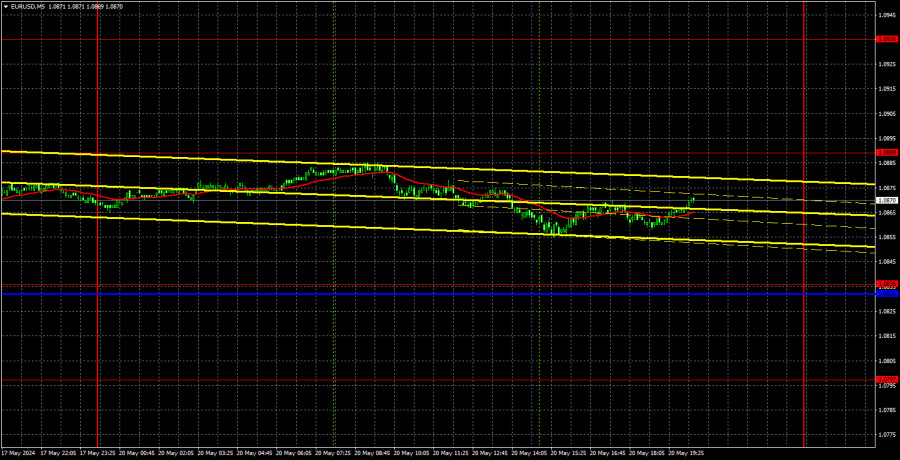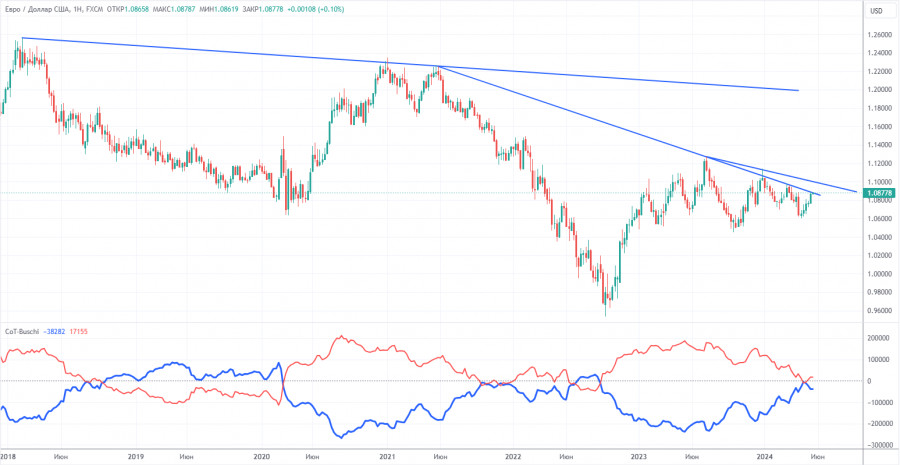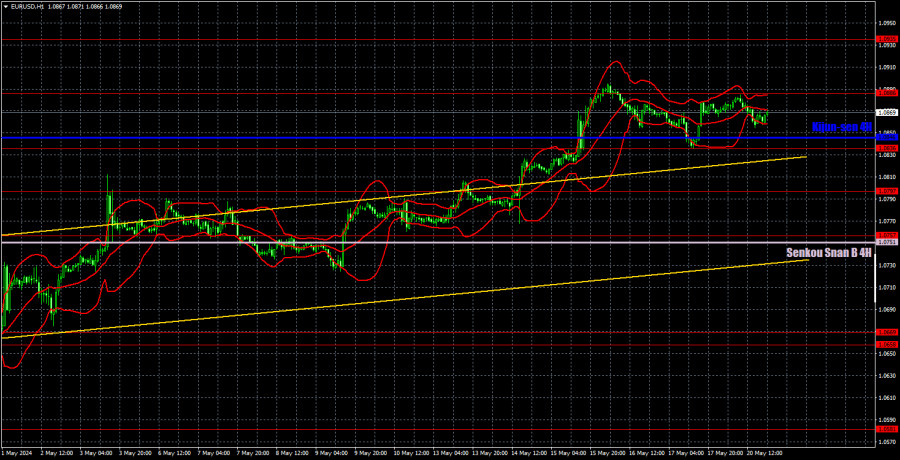

EUR/USD was unable to continue its upward movement, nor did it start a bearish correction. In general, the pair traded sideways between the levels of 1.0836 and 1.0886 all day. From our perspective, the flat phase was not unusual, but the fact that the euro cannot move away from its local highs. The market clearly showed that it is ready to buy the euro without any particular reason. So it seems that a bearish correction is not necessary. Therefore, we can probably expect a new upward movement. Perhaps the market is waiting for new macro data or fundamental events to start buying, but why? It appears that the market does not need any reasons to buy the pair right now!
From a technical perspective, the pair is above the ascending channel and above the Ichimoku indicator lines. Therefore, there is currently no basis for expecting the end of the growth. If the price consolidates below the Kijun-sen line, then we can expect it to fall to the Senkou Span B line. However, even with such consolidation, the dollar is currently facing significant problems. The euro continues to show an illogical rise and is gaining momentum.
No trading signals were formed on Monday. The pair's volatility was a mere 30 pips, so it's a good thing that there were no signals. The pair continues to trade very sluggishly.
COT report:
The latest COT report is dated May 14. The net position of non-commercial traders has been bullish for a long time, but now the situation has finally changed. The net position of non-commercial traders (red line) has been decreasing in recent months, while that of commercial traders (blue line) has been increasing. This shows that market sentiment is turning bearish, as speculators increasingly sell the euro. Currently, their positions coincide in terms of volume. We don't see any fundamental factors that can support the euro's strength, while technical analysis also suggests a continuation of the downtrend. Three descending trend lines on the weekly chart indicate that there's a good chance of further decline.
The red and blue lines have crossed, and now the bears might gain a significant advantage. So we strongly support the euro's decline. During the last reporting week, the number of long positions for the non-commercial group increased by 7,800, while the number of short positions decreased by 4,700. Accordingly, the net position increased by 12,500. Overall, both the euro and the net position continue to decline. The number of buy contracts is only higher than the number of sell contracts among non-commercial traders by 17,000.
Analysis of EUR/USD 1H
On the 1-hour chart, the EUR/USD pair has been going through a weak but steady bullish correction against the broader downtrend for a month. Since expectations for a Federal Reserve rate cut in 2024 have significantly decreased, we believe that the US currency should rise in the medium term. We still expect the price to consolidate below the ascending channel so the downtrend can resume. However, it seems that the market is not ready to buy the dollar under any circumstances, regardless of the situation. The euro simply rises almost every day, often without even having local reasons for it.
On May 21, we highlight the following levels for trading: 1.0530, 1.0581, 1.0658-1.0669, 1.0757, 1.0797, 1.0836, 1.0886, 1.0935, 1.1006, 1.1092, as well as the Senkou Span B (1.0751) and Kijun-sen (1.0846) lines. The Ichimoku indicator lines can move during the day, so this should be taken into account when identifying trading signals. Don't forget to set a Stop Loss to breakeven if the price has moved in the intended direction by 15 pips. This will protect you against potential losses if the signal turns out to be false.
On Tuesday, there are no significant events scheduled in either the Eurozone or the US. Therefore, we expect low volatility, and the euro may continue to rise or simply remain at local highs.
Description of the chart:Support and resistance levels are thick red lines near which the trend may end. They do not provide trading signals;
The Kijun-sen and Senkou Span B lines are the lines of the Ichimoku indicator, plotted to the 1H timeframe from the 4H one. They provide trading signals;
Extreme levels are thin red lines from which the price bounced earlier. They provide trading signals;
Yellow lines are trend lines, trend channels, and any other technical patterns;
Indicator 1 on the COT charts is the net position size for each category of traders;